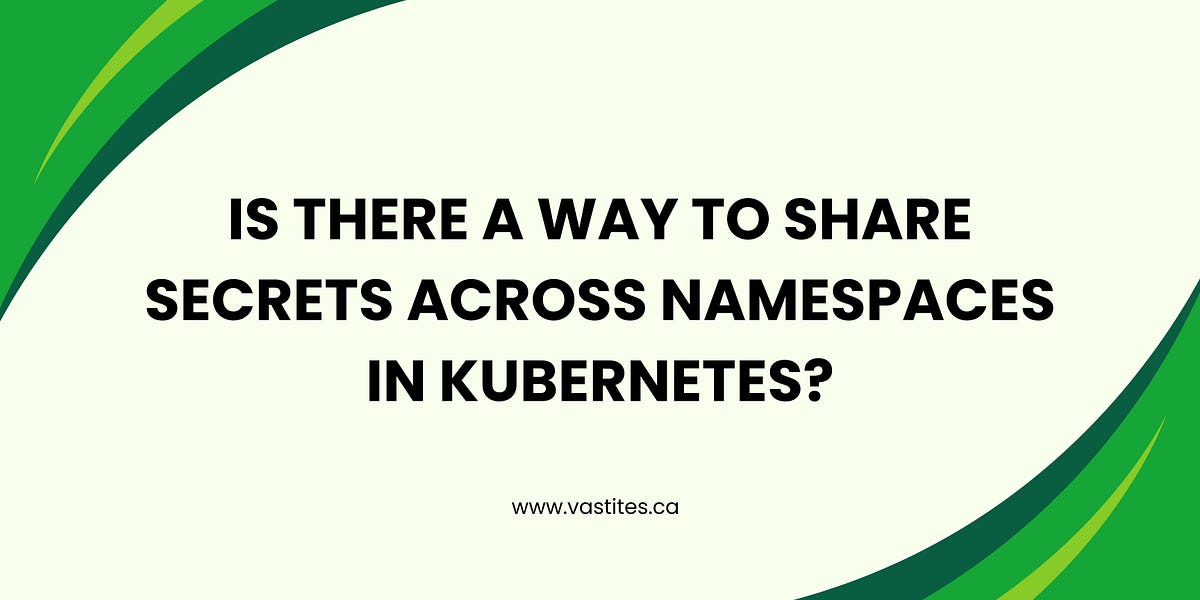Kubernetes Secrets Across Namespaces: A Guide
Learn how to securely share secrets across namespaces in Kubernetes for seamless application deployment and management.
Learn how to securely share secrets across namespaces in Kubernetes for seamless application deployment and management.
Kubernetes, while powerful, doesn't allow direct sharing of secrets across namespaces for important security and architectural reasons. This restriction ensures that sensitive data remains protected and namespace isolation, a key principle of Kubernetes, is maintained. However, there are several workarounds to enable sharing secrets between namespaces when needed. This article explores the reasons behind this restriction and outlines various methods to safely and effectively share secrets across namespaces in your Kubernetes clusters.
Kubernetes doesn't directly support sharing secrets across namespaces. Here's why and how to work around it:
Why Direct Sharing is Not Allowed:
Workarounds:
Copy the Secret:
kubectl get secret <secret-name> -n <source-namespace> -o yaml | kubectl create -f - -n <target-namespace>Use a Tool for Synchronization:
Tools like reflector or kubernetes-replicator can automate copying and updating secrets across namespaces. This provides a more dynamic solution.
Example using kubernetes-replicator:
apiVersion: v1
kind: ConfigMap
metadata:
name: replicator-config
data:
replicateFrom: "source-namespace"
replicateTo: "target-namespace"
---
apiVersion: apps/v1
kind: Deployment
# ... Deployment configuration for kubernetes-replicatorConsider Third-Party Solutions:
Important Considerations:
This code provides examples of workarounds for sharing Kubernetes secrets across namespaces. It includes methods for copying secrets, using the kubernetes-replicator tool for synchronization, and integrating HashiCorp Vault for secret management. The examples cover creating ConfigMaps, deploying replicators, and configuring Vault Agent Injectors. Remember to replace placeholders with actual values and adapt the code to your specific environment. Prioritize security and refer to official documentation for detailed instructions.
This document provides code examples for the workarounds mentioned in the article about sharing Kubernetes secrets across namespaces.
1. Copy the Secret:
This example demonstrates copying a secret named "my-secret" from the "source-namespace" to the "target-namespace":
kubectl get secret my-secret -n source-namespace -o yaml | kubectl create -f - -n target-namespace2. Use a Tool for Synchronization:
a) Using kubernetes-replicator:
This example demonstrates using kubernetes-replicator to synchronize secrets from "source-namespace" to "target-namespace":
Step 1: Create a ConfigMap for Replicator Configuration:
apiVersion: v1
kind: ConfigMap
metadata:
name: replicator-config
namespace: kube-system # Choose your desired namespace
data:
replicateFrom: "source-namespace"
replicateTo: "target-namespace"Step 2: Deploy the kubernetes-replicator:
apiVersion: apps/v1
kind: Deployment
metadata:
name: kubernetes-replicator
namespace: kube-system # Choose your desired namespace
spec:
replicas: 1
selector:
matchLabels:
app: kubernetes-replicator
template:
metadata:
labels:
app: kubernetes-replicator
spec:
containers:
- name: kubernetes-replicator
image: stakater/kubernetes-replicator:v0.1.0 # Use the latest version
args:
- --configmap=kube-system/replicator-config # Point to your ConfigMap
imagePullPolicy: Always3. Consider Third-Party Solutions:
This example demonstrates integrating HashiCorp Vault with Kubernetes using the official Vault Agent Injector:
Step 1: Install Vault and Configure Kubernetes Auth Method (Refer to Vault Documentation)
Step 2: Deploy Vault Agent Injector:
helm repo add hashicorp https://helm.releases.hashicorp.com
helm install vault-agent-injector hashicorp/vault-secrets-operator --version 0.10.0Step 3: Annotate your Pod to Request Secrets from Vault:
apiVersion: v1
kind: Pod
metadata:
name: my-app
annotations:
vault.hashicorp.com/agent-inject: "true"
vault.hashicorp.com/role: "my-app-role" # Replace with your Vault role
vault.hashicorp.com/secret-volume-path: "secrets" # Mount path for secrets
spec:
# ... your pod configuration
containers:
- name: my-app
image: my-app-image
volumeMounts:
- name: secrets
mountPath: "/var/secrets"
volumes:
- name: secrets
emptyDir: {}Important Notes:
<secret-name>, <source-namespace>, <target-namespace> with your actual values.Security:
Operational Considerations:
Alternatives to Secret Sharing:
Remember:
Problem: Kubernetes doesn't allow direct sharing of secrets across namespaces for security and isolation reasons.
Why?
Workarounds:
| Method | Description | Pros | Cons |
|---|---|---|---|
| Manual Copying | Use kubectl to copy the secret to the target namespace. |
Simple, easy to understand. | Requires manual updates for changes. |
| Synchronization Tools | Utilize tools like reflector or kubernetes-replicator to automate copying and updates. |
Dynamic, reduces manual effort. | Requires setup and configuration. |
| Third-Party Solutions | Leverage tools like HashiCorp Vault or AWS Secrets Manager for centralized secret management and Kubernetes integration. | Robust features, strong security. | May introduce complexity and dependencies. |
Key Considerations:
While Kubernetes prioritizes security and isolation by not allowing direct secret sharing across namespaces, several workarounds exist to enable this functionality when needed. You can manually copy secrets, employ synchronization tools like kubernetes-replicator, or leverage third-party solutions like HashiCorp Vault. When choosing a method, carefully weigh the security implications, automation needs, and auditing requirements. Remember to prioritize security best practices, automate where possible, and monitor your chosen solution to ensure the safe and effective management of your sensitive data in Kubernetes.
 Is there a way to share secrets across namespaces in Kubernetes ... | Yes, there are ways to share secrets across namespaces in Kubernetes, though Kubernetes does not natively allow direct sharing of secrets…
Is there a way to share secrets across namespaces in Kubernetes ... | Yes, there are ways to share secrets across namespaces in Kubernetes, though Kubernetes does not natively allow direct sharing of secrets… Syncing Secrets Across Namespaces - cert-manager Documentation | Learn how to synchronize Kubernetes Secret resources across namespaces
using extensions such as: reflector and kubernetes-replicator.
Syncing Secrets Across Namespaces - cert-manager Documentation | Learn how to synchronize Kubernetes Secret resources across namespaces
using extensions such as: reflector and kubernetes-replicator. Sharing Secrets Across Namespaces in Kubernetes | Baeldung on ... | Learn about creating Secret objects in Kubernetes and how to share the same Secret object across different namespaces.
Sharing Secrets Across Namespaces in Kubernetes | Baeldung on ... | Learn about creating Secret objects in Kubernetes and how to share the same Secret object across different namespaces. Accesing resources through different namespaces - General ... | If I have an app service deployed via helm in namespace dev, could this service access to a secret defined in namespace default? Or What is the namespace which the other resources in other namespaces can have access? Maybe kube-public? kube-public This namespace is created automatically and is readable by all users (including those not authenticated). This namespace is mostly reserved for cluster usage, in case that some resources should be visible and readable publicly throughout the whole...
Accesing resources through different namespaces - General ... | If I have an app service deployed via helm in namespace dev, could this service access to a secret defined in namespace default? Or What is the namespace which the other resources in other namespaces can have access? Maybe kube-public? kube-public This namespace is created automatically and is readable by all users (including those not authenticated). This namespace is mostly reserved for cluster usage, in case that some resources should be visible and readable publicly throughout the whole... Reference single imagePullSecrets secret from multiple namespaces | Cluster information: Kubernetes version: 1.18 Cloud being used: AWS I’ve created a secret for dockerhub authentication, and I’m referencing it in a pod imagePullSecrets entry to authenticate to dockerhub. I understand the recommended way to allow workloads in different namespaces to authenticate would be to create the secret in each namespace, adn reference that secret in the pods imagePullSecrets. But I would like to only create the secret in one namespace, then reference that secret in th...
Reference single imagePullSecrets secret from multiple namespaces | Cluster information: Kubernetes version: 1.18 Cloud being used: AWS I’ve created a secret for dockerhub authentication, and I’m referencing it in a pod imagePullSecrets entry to authenticate to dockerhub. I understand the recommended way to allow workloads in different namespaces to authenticate would be to create the secret in each namespace, adn reference that secret in the pods imagePullSecrets. But I would like to only create the secret in one namespace, then reference that secret in th... Share kubernetes secrets between namespaces? | Jhooq | Nov 12, 2021 ... As being an API object kubernetes secrets can not be shared between the namespaces,so the other way would be to copy the Kubernetes secrets from ...
Share kubernetes secrets between namespaces? | Jhooq | Nov 12, 2021 ... As being an API object kubernetes secrets can not be shared between the namespaces,so the other way would be to copy the Kubernetes secrets from ... How to use the same wildcard TLS certificate in multiple ... | I have one wildcard TLS certificate, and in order to use it in different namespaces, I have created multiple Secrets containing the same TLS certificate. I have multiple IngressRoutes in different namespaces for hosts such as traefik.mydomain.com, linkerd.mydomain.com. I am being flooded by following warnings: Skipping addition of certificate for domain(s) "*.mydomain.com,mydomain.com", to EntryPoint default, as it already exists for this Entrypoint." First of all, creating multiple Secrets ...
How to use the same wildcard TLS certificate in multiple ... | I have one wildcard TLS certificate, and in order to use it in different namespaces, I have created multiple Secrets containing the same TLS certificate. I have multiple IngressRoutes in different namespaces for hosts such as traefik.mydomain.com, linkerd.mydomain.com. I am being flooded by following warnings: Skipping addition of certificate for domain(s) "*.mydomain.com,mydomain.com", to EntryPoint default, as it already exists for this Entrypoint." First of all, creating multiple Secrets ...